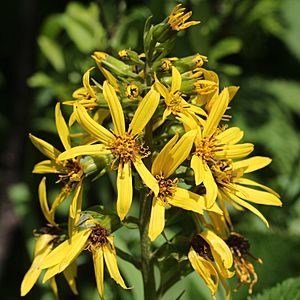Ligularia fischeri facts for kids
Quick facts for kids Ligularia fischeri |
|
|---|---|
 |
|
| Scientific classification | |
| Genus: |
Ligularia
|
| Species: |
fischeri
|
| Synonyms | |
|
Synonyms
Cineraria elata Steud.
Cineraria fischeri Ledeb. Cineraria speciosa Fisch. ex Turcz. Cineraria speciosa Schrad. ex Link Hoppea speciosa (Schrad. ex Link) Rchb. Ligularia fischeri f. fischeri Ligularia glabrescens Vorosch. Ligularia racemosa DC. Ligularia sibirica var. longibracteata Kitam. Ligularia sibirica var. racemosa (DC.) Kitam. Ligularia sibirica var. speciosa (Schrad. ex Link) DC. Ligularia speciosa (Schrad. ex Link) Fisch. & C.A.Mey. Senecio ligularia var. atkinsonii (C.B.Clarke) Hook.f. Senecio ligularia var. ligularia Senecio racemosus Wall. [Invalid] |
|
Ligularia fischeri is a plant known by many names. Some common names are gomchwi, Fischer's ragwort, or Fischer's leopard plant. It belongs to the Ligularia group of plants, which is part of the Asteraceae family. This plant naturally grows in East Asia.
About Fischer's Ragwort
Ligularia fischeri is a plant that grows in clumps. It is a perennial plant, meaning it lives for more than two years. It can grow quite tall, reaching up to 2 meters (about 6.5 feet).
The plant has large, light green leaves at its base. These leaves are shaped like a kidney and have rough, jagged edges. They can be as wide as 40 centimeters (about 16 inches) and grow on long stems. The leaves higher up on the main stem are smaller and have shorter stems.
In the middle of summer, Ligularia fischeri produces bright yellow flowers. These flowers grow on tall stalks, which can be up to 75 centimeters (about 30 inches) long. Each flower head is about 5 centimeters (2 inches) across. After the flowers bloom, the plant makes seed capsules. These capsules hold seeds that have soft, downy hairs, often tinged with brown or purple.
Gomchwi in Korean Food
In Korean cuisine, the leaves of gomchwi are very popular. They are often used to make special side dishes called namul. Namul are usually made from different kinds of herbs and vegetables.
There are several ways to enjoy gomchwi in Korea:
- Pickled: Gomchwi leaves can be pickled to make a dish called jangajji. This gives them a tangy and savory flavor.
- Kimchi: Like kimchi, gomchwi can also be fermented. This creates a unique and flavorful side dish.
- Fresh Wraps: People also eat fresh gomchwi leaves as a ssam. This means they use the leaf to wrap around a bite of rice and other ingredients.
-
Gomchwi-jangajji (pickled gomchwi)


